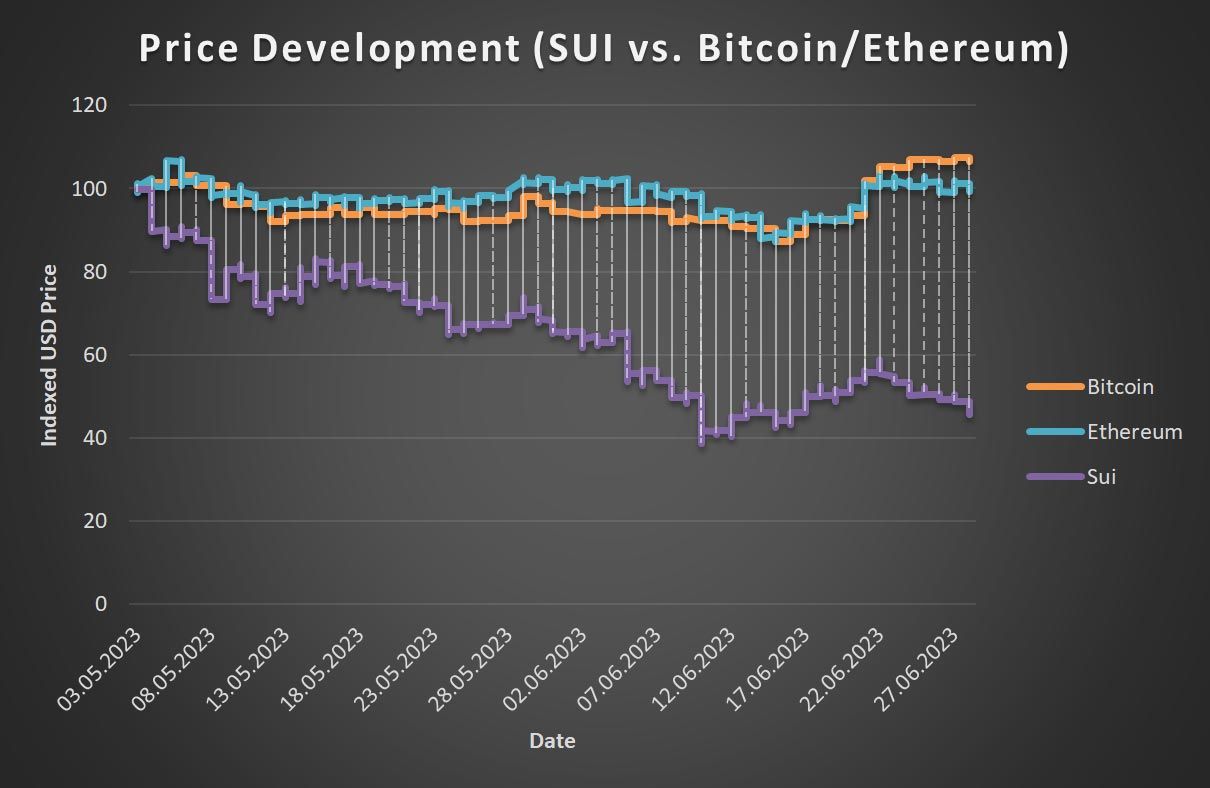
Monthly Rising Coin Report – Sui
#digitalassets #crypto
Sui Overview – The Facts

What is Sui – The Newbie’s Summary
Sui is an innovative Layer 1 blockchain and smart contract platform that has been meticulously designed to revolutionize the landscape of digital asset ownership. It offers features such as swiftness, privacy, security, and inclusivity, setting new standards in the domain. Sui’s fundamental model, built upon the Move programming language, adopts an object-centric approach, facilitating parallel execution, near-instantaneous finality, and robust on-chain assets, delivering unparalleled speed at a minimal cost. Sui is considered a significant leap forward in blockchain technology, serving as a stepping stone for creators and developers to forge extraordinary and user-centric experiences.
How does Sui Work – The Nerd’s Perspective
The Sui blockchain introduces an innovative approach to achieve impressive speed and scalability. By capitalizing on the fact that many blockchain transactions involve non-overlapping states, Sui enables parallel processing and eliminates the need for consensus in simple transactions. This unique design ensures nearly instantaneous transaction finality as requestors or proxies can actively communicate with validators, enabling real-time transaction completion.
Validators, the independent entities operating the Sui network, execute transactions involving exclusively owned objects in parallel, ensuring high throughput through the use of the Byzantine Consistent Broadcast mechanism. Transactions involving shared objects, which can be modified by multiple users, necessitate consensus. To reach consensus, Sui utilizes Bullshark for validators, a high-throughput DAG-based (DAG = directed acyclic graph) consensus protocol, and the Narwhal DAG-based mempool.
Sui guarantees eventual consistency by ensuring that all honest validators will eventually process a transaction and reach the same state. Sui distinguishes between two asset types: owned objects and shared objects. Consensus is only necessary for transactions involving shared objects, whereas transactions on single-owner objects can be executed rapidly and without the need for consensus.
Sui employs a transaction validation approach that facilitates parallel execution and low latency. Each transaction undergoes individual validation, and successful transactions promptly receive a certificate of finality, ensuring their processing by the Sui network.
Regarding scalability, Sui does not impose a total order on transactions exclusively involving owned objects. Instead, it achieves scalability by causally ordering transactions based on their dependencies. Transactions involving shared objects are ordered using Bullshark consensus, which scales effectively by adding more machines per validator.
Sui provides support for smart contracts through Sui Move, a robust adaptation of Move specifically tailored for the Sui blockchain. Sui Move offers strong inherent security and a more user-friendly programming model, empowering developers to write smart contracts with confidence.
At the core of Sui’s architecture are programmable objects, divided into mutable data values and immutable packages, managed through Move packages. Transactions play a vital role in updating the Sui ledger, encompassing input object references and a pointer to a Sui Move code object. This facilitates updates to existing objects and the creation of new objects within the ledger. Smart contracts in Sui are written in Sui Move, a secure and expressive dialect of the Move language. Sui Move’s type system and data model naturally align with the parallel execution strategies that contribute to Sui’s scalability.
What makes Sui Unique – For the Special One
Sui distinguishes itself among other traditional blockchain with these main advantages:
- High Performance: Sui achieves unprecedented performance by causally ordering transactions, allowing for parallel execution and reduced latency. The complexity is shifted to the client, minimizing interactions with validators and enabling workload offloading to enhance the user experience. Unlike traditional blockchains, Sui operates at network speed without waiting for system timeouts, increasing efficiency. It can also leverage multiple machines per validator, further enhancing performance.
- Performance under Faults: Sui employs a leaderless protocol for simple transactions, ensuring that faulty validators have minimal impact on performance. For transactions involving shared objects, a consensus protocol with no view-change sub-protocol is used, resulting in only slight performance degradation. In contrast, leader-based blockchains experience significant drops in throughput and increased latency when a validator crashes.
- Security Assumptions: Unlike many traditional blockchains, Sui does not rely on strong network synchrony assumptions. It maintains its security properties even under adverse network conditions, splits/partitions, or powerful DoS attacks targeting validators. In contrast, synchronous blockchains can face double-spending and deadlocks during sustained network attacks.
- Efficient Local Read Operations: Sui’s reading process differs significantly from other blockchains. Users interested in specific objects can perform authenticated reads with low granularity and latency. Sui creates a narrow family tree of objects starting from the genesis, enabling reading of only relevant objects. For users needing a global view of the system, checkpoints can be utilized to improve performance. In traditional blockchains, ordering families of objects can lead to performance bottlenecks due to disk I/O.
- Easier Developer Experience: Sui provides a developer-friendly environment with features such as the Sui Move and object-centric data model, asset-centric programming, and an overall smoother development experience.
How has Sui Developed – For the Visually Attracted

What’s in it for me – For You (Maybe)
If you are a gamer or in any way related to the gaming industry, you will certainly hear from Sui. Sui has quickly become an attractive platform for Web3 game developers, despite being a newcomer to the space. Unlike other established Web3 gaming networks like Polygon and Solana, Sui offers unique features such as parallel transaction processing and horizontal scalability, enabling it to maintain low transaction fees as more games and decentralized apps come online. Sui’s object-based model appeals to game designers, allowing for dynamically updated NFTs and the ability to evolve in-game asset NFTs over time. The network aims to prioritize great games built by developers seeking to enhance player experiences using Web3 technology. Sui’s mainnet has already attracted over 40 game projects, including a “Walking Dead” game, Final Stardust, Project Eluune, Run Legends, Worlds Beyond, and Bushi. Developers appreciate Sui’s usability for gaming and its fast transaction speed, making it suitable for high-end, AAA role-playing games like Abyss World. The goal is to create an immersive, community-driven experience where players can earn in-game items on-chain and even launch their own private servers. Sui’s innovative features and focus on gameplay are positioning it as a promising platform for Web3 game development.
Disclaimer: “This report is for information and knowledge transfer purposes only and is not an investment recommendation.”
Sources: mystenlabs.com, docs.sui.io, coinmarketcap.com, decrypt.co/139169/sui-built-games-heres-why-developers-bullish

Contact the author
Martin Rupprecht
E-Mail: martin.rupprecht@horn-company.de

Contact the author
Philipp Misura
E-Mail: Philipp.Misura@horn-company.de
